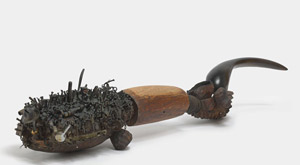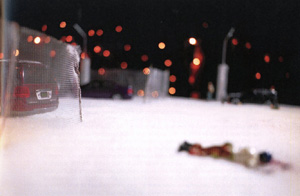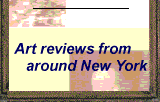Visible Man
John Haberin New York City
Jack Whitten and Hank Willis Thomas
How do you paint an invisible man? When Jack Whitten paints his homage to Ralph Ellison, it is his Black Monolith, and his imagined portrait is black and nearly five feet tall. It is black enough to create a mask that not even Whitten can penetrate, which is saying a lot.
Of course, he would not be up to the challenge without Invisible Man, among the most haunting works of American fiction. Ellison's invisible man is very much alive every time someone looks between its covers. Nor is it merely a pathology in the mind of black man in a basement with too much to say. It is a reality, it asserts, that a black man can never escape as long as white America chooses to look the other way. Unless, that is, white America chooses to look and sees only its fears. Unless, too, a creative artist stakes out his own presence in sixty years of work at MoMA. 
That inviting and imposing face stares out from the entrance to a Jack Whitten retrospective, and he throws everything he can at it, including molasses, copper, salt, chocolate, and rust. The work contains broken eggshells, too, consistent with its broken tiles and mirrors, for a wide-open white background to a colorful work of art. If it is a rough assemblage, he is not hiding the damage. And if its materials are sticky, he was already well into his career in 1994, and he planned on being around a long time. He could return for inspiration to enough black and white Americans to keep you on your toes the whole way. He could also plan on being first and foremost an abstract painter.
In contrast, everything for another black artist is a smart twist on race, class, and history, to the point that it may be hard to believe that everything from Hank Willis Thomas recent and new. Just do not let it knock you off your stride too easily or too hard. As his show's title says, "I Am Many"—or, as a canvas has it, in white block letters, EVERYTHING. He does not quite paint everything at once of course. Starting at the entrance desk, his familiar imagery of hands sets the stage sculptural black and white. Will one nurture or betray the other?
An ongoing experiment
For Jack Whitten, persistence gave him the power to look back at both painting and America. He rang the changes on black abstraction, along with such artists as Sam Gilliam and Melvin Edwards. He lived through the fall of the Twin Towers and paid tribute to that, too. He took art into the digital era, with toner for his black. He was only, as the show's title has it, "The Messenger," but with a message he insists others hear. He kept starting over until others got the message, too, and so did he.
He made it easy. He worked in familiar genres, including spatters and stripes. He made his studio below Canal Street, where he could see Ground Zero and share the memories with anyone. At the same time, he made building a career anything but easy and invisibility almost inevitable. He abandoned figurative paintings and his homage to African Americans just when abstract art was giving way to critical thinking, conceptual art, and diversity. He kept changing just when a growing market for art demanded a signature that sells.
Invisible Man is tormented and angry, and Whitten is neither. There was always too much new to learn and to see. He was working class through and through, the son of a coal miner and seamstress in Alabama. Bessemer, a suburb of Birmingham, shares its very name with a process for making steel, but his parents were determined that he be the family's first to attend college. He went as a premed, but dropped out to make art. Imagine him at just twenty in 1960, arriving in New York.
He found friends easily, from Willem de Kooning to Romare Bearden and from Abstract Expressionism to African American art. He had already thrown himself into the civil-rights movement. He could be an activist by day, a museum-goer on weekends, and a regular in Brooklyn jazz clubs by night. His brother was a jazz musician himself. His mentors taught him, as Edwards said, that painting was a form of improvisation but in forms inherited from the past. He and his wife summered in Greece and Crete where art and myth go back a very long way.
He dedicated much of his early work to his influences, which to him meant people. Other drivers were light and color, and they pushed him away from narrative painting. After a start with a loose haze, he used successive layers to blur the boundaries between horizontal stripes and to create a greater radiance. He favored orange and other departures from red, yellow, and blue to insist on the light. Materials were the greatest driver of all, and horizontal incisions run the entire width of a painting, leaving the stripes in low relief. He could make the cuts with a rake or a comb.
Whitten liked acrylic because he could layer it—and because he could make it dry slowly or fast. He could apply it to plastic sheets that could become the painted surface, even after he peeled them away, much like Beatriz Milhazes in Brazil. They become that much more visible when he abandons stripes for splashes of acrylic, for at once the free layered geometry of color-field painting and an underlying single color to the entire canvas. Much the same materials drew him to abandon color for black and white. He served as artist in residence at Xerox, where he experimented with toner. One can think of his entire career as an ongoing experiment.
Multiplicity and ambition
What, though, is the subject of his experiment? If he keeps changing, is there a constant to his art—or something he has been missing all along? Either way, there is a lot to see. Whitten has the entire sixth floor, reserved for MoMA's largest exhibitions. White latticed partitions for drawings bring them closer to materials, too and to the paintings. A huge central room holds more than one work in series all by itself.
The curator, Michelle Kuo, makes the case for an artist with many interests. Whitten found success early, with a 1994 show at the Whitney, and his influence extends to the broken tiles and mirrors of Rashid Johnson at the Guggenheim today. His many directions mean nothing less than a greater ambition. Any painter who thinks that abstract art encompasses activism and music is already thinking big. And anyone who thinks that it translates into all of western art and a science experiment is thinking even bigger. Those deep black paintings see stars.
Thinking big comports with Whitten's one obvious constant, working big. It connects to his first loves in Abstract Expressionism and Mediterranean wall tiles. And work only grew. A triangle in honor of Malcolm X reaches to over feet in width, but the single largest is the tribute to 9/11, whose central image could be the Great Pyramid. Why? Puzzles like that abound, not always to the work's advantage, but something big is going on.
A less obvious constant denies the whole question of his departures. With each new series, Whitten builds on and challenges past work. A late shift to ceramics recalls the painting for Invisible Man well before. Cuts recall a razor blade embedded in paint at its center. Ghostly images in black recall some of his earliest experiments, in abstract photography. They are passing through an unknown space, still finding their way.
They speak of the fate of invisible men, which points to one last constant. Those many histories from politics to music are his own as a New Yorker, a southerner, and a black. Whitten cultivates the tension between African American history and a history for all Americans. So does Whitten's sculpture, inspired by folk and African art. It would be a new history, of grief and grievance, refuge and restitution, but such is the point. It would also be art.
Whitten has paid a price for so often changing his mind. I myself cannot always justify his departures or his returns. There are more luminous abstractions than his and more pointed tributes to the past. Not many, though, and they stand out at a time when diversity so often demands blind self-affirmation. Surely Whitten has better things to worry about than taking credit. After so many years, he can make his own totems.
Not all heavy
Nobody goes to see art there anymore. It's too crowded. New Yorkers know the routine by now, even those of us who cannot aspire to its privileges. I am still agonizing over the fate of East Village art from the 1980s, Williamsburg, Bushwick, and Dumbo. Thirty years after Soho galleries left for West Chelsea, I am still trying to know what to make of it. It has not kept David Zwirner from hiding to the unwary in Tribeca as simply 52 Walker.
Many galleries welcome in September with the fall art fairs, meaning mostly two things at once and two expenses. They have to do so, just to be seen. They bring with them as much as they can of the past as well. That, too, to be seen. Jordan Nassar indulges in both tiling and weaving with an eye to Byzantium,  . I could complain, but it is nothing if not suitably traditional. When Tribeca, too, is reverential like this, you know art has gained in confidence or lost in courage.
. I could complain, but it is nothing if not suitably traditional. When Tribeca, too, is reverential like this, you know art has gained in confidence or lost in courage.
More subtly, Tribeca has taken over the first half of a downtown gallery guide and then some. It took all of this and then some to maintain and to expand the guide after its creator died and galleries hit the road once more. A Lower East Side guide could not last on its own. But now the downtown guide has relegated the Lower East Side to its smaller, second half. Could that be why, as if to moderate the trend, shows in the guide look awfully familiar? Or could art just be settling in—not least with Hank Willis Thomas?
Some work for Thomas and his gallery's impressive Tribeca space brings faces, messages, or something more elusive. Are these sculptures dangerous devices or sources of power? Other work, a stripe or a maze, present a color-field painting. It may or may not pull him back from race to supposed universals in the wake of Frank Stella and Jasper Johns, territorial boundaries and a mitred maze. Perhaps identity itself for a black male is a maze. Like the building, it pulls him into history.
I had a chance to recover a special New York, but would it come to me? Has Thomas sought safe ground in which any race can appear? Like Walt Whitman, does he contain multitudes? Does any proper artist? A flag hangs at rest in one photo, as in an old-fashioned classroom. A neon sign blinks between LOVE RULES and OVER RULES. It could still be trying to define what the choice means to Trump's America.

Jack Whitten ran at The Museum of Modern Art through August 2, 2025, Jordan Nassar at James Cohan through October 4, and Hank Willis Thomas at Jack Shainman through November 1. A related review looks at Jack Whitten sculpture.




